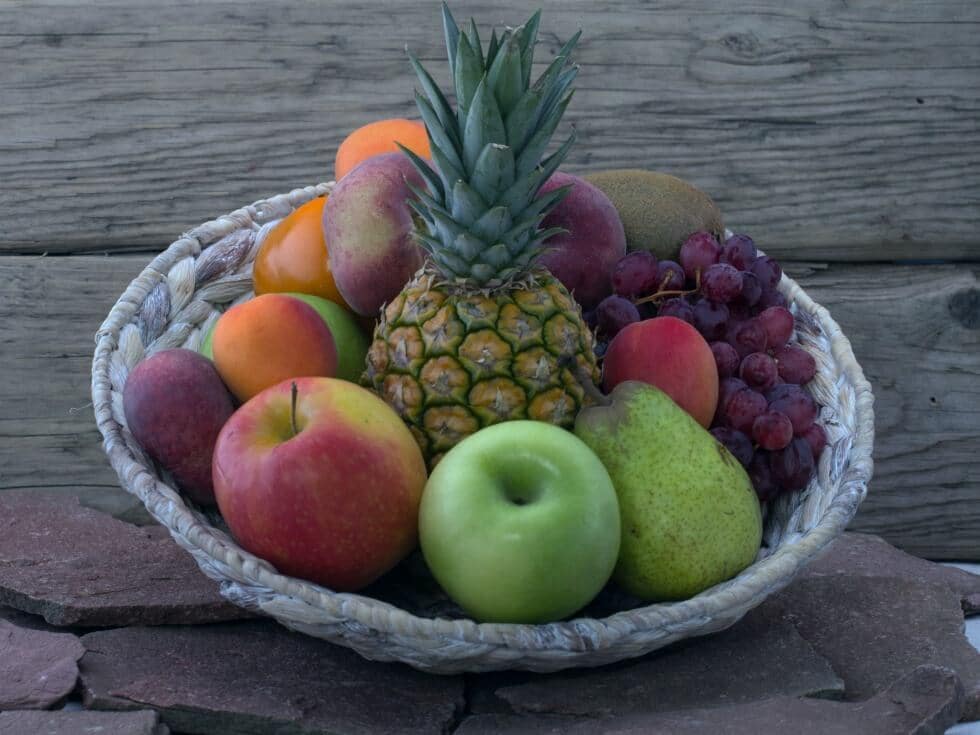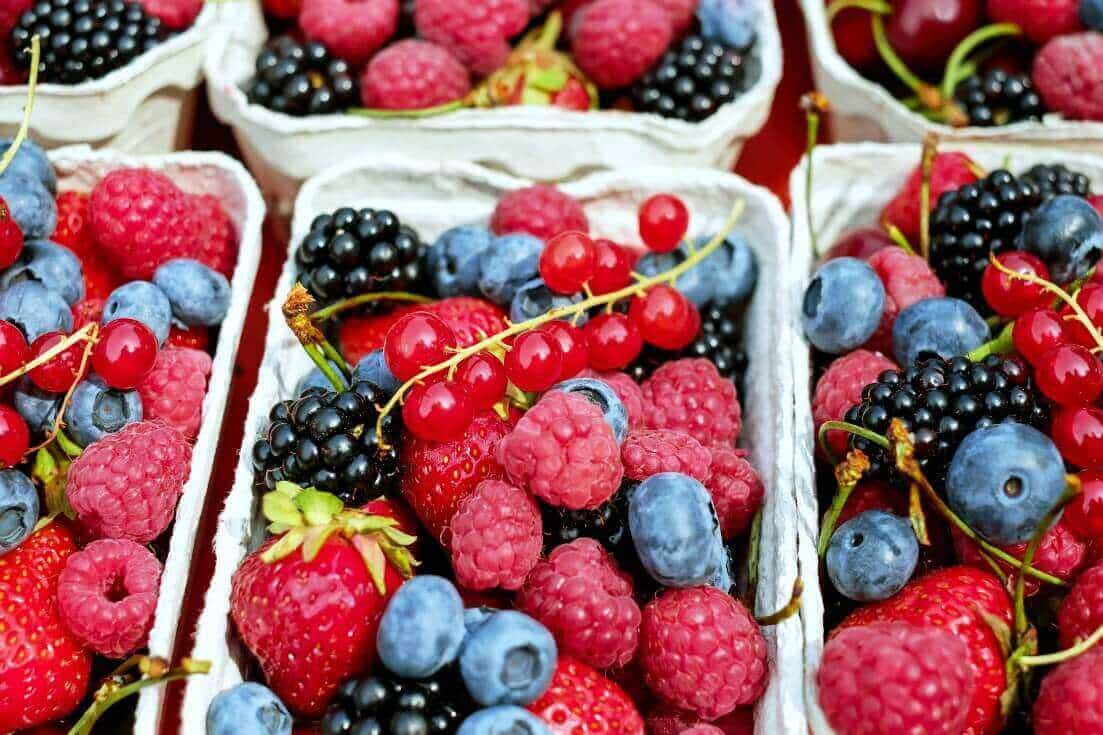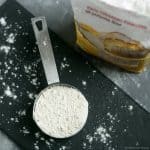It’s the heart of winter so you might not be craving fruit right now. But, when you do have sweet cravings, what’s the best low carb fruits to have?

Watching your carbs? Is it because you want to get as lean as possible? Or, are you just concerned about managing blood sugar and inflammation?
Whatever the reason, there seems to be some confusion about fruit.
Is fruit healthy if you’re living a low carb lifestyle? What are the best low carb fruits to eat?
We’ll reveal a low carb fruit list shortly. But first, let’s address the nutritional paradox that is fruit….
When you were a young kid, you were likely told fruit is good for you. You may not have known about antioxidants years ago. But you likely possessed an innate sense that fruit is good.
Too much of anything, of course, is not good for you. This includes fructose, the main sugar found in fruit. Fructose is a natural sweetener. That is, unless it’s processed into high fructose corn syrup.
If you’re a low carb dieter should you be concerned about fruit sugar?
And should you really be concerned about how many grams of carbs a particular fruit has? A list of low carb fruits is a good reference.
But is it telling you the whole story? Or is it more like stepping on a scale? The scale reveals how much you weigh.
However, it’s just a number. Your weight doesn’t reveal how much of your weight is lean muscle mass, body fat and water weight.
Similarly, the amount of carbs in fruit doesn’t reveal the whole picture. The number of carbs doesn’t tell you how those carbs are being metabolized.
And the amount of carbs in a fruit doesn’t disclose all the amazing health benefits of the compounds in a specific fruit.
Sure, there are some fruits that are best avoided if you’re watching carbs. We’ll get to those at the end. But first, here’s the important question if you’re eating low carb….

Is fructose in fruit bad for you?
There’s still a lot of fructose hysteria on the internet.
There’s no doubt that fructose is sweet. But is that a bad thing? If you’re low carb living, the sweeter a food, can actually mean sometimes the better. That’s because you need less of it to satisfy your sweet tooth.
The gold standard for sweetness is sucrose, which is table sugar. Sucrose measures 100 on the sweetness scale. Fructose measures even higher, on average, 140 or higher.
That doesn’t mean that fructose is worse for you than table sugar.
The way fructose is metabolized does not elevate your blood sugar that much.
Studies have shown that fructose in fruit is not to blame for fructose-related liver toxicity and high blood pressure in people with diabetes. It’s only added sugars like HFCS that are the cause.
Natural fructose has a relatively low glycemic index (GI). The GI is a measure of how carbohydrates affect blood sugar concentrations. The glycemic load per gram of fructose is only 19. Table sugar is 65.
If you’re thinking about eliminating most fruit from your diet, keep in mind, fruits contain antioxidant compounds such as phenols.
And,if you completely ditch fruit because you’re worried about fruit carb grams, you may miss out on key anti-aging nutrients.
That being said, let’s take a look at a low carb fruit list.
Here are the best fruits to eat if you’re worried about carbs in fruit. They are in order from lowest to highest in amount of carbs, per their respective serving size.
Low Carb Fruits List
- Olives (green pitted; 1.6 grams per ounce)
- Cherry tomatoes (1.8 gram per ounce)
- Olives (black pitted; 1.8 grams per ounce)
- Rhubarb (2.8 grams per ½ cup cubed)
- Tomato (2.4 grams per 62g serving)
- Apricot (3.8 grams in a medium-sized 35g fruit)
- Grapes (4.1 grams per 10 medium seedless)
- Passion fruit (4.2 grams in a medium-sized 18g fruit)
- Lychees (4.7 grams per ounce)
- Cranberries (5.0 grams per ½ cup)
- Prune (5.4 grams per each dried and pitted prune)
- Strawberries (5.5 grams per ½ cup)
- Blackberries (6.9 grams per ½ cup)
- Raspberries (7.3 grams per ½ cup)
- Red currants (7.7 grams per ½ cup)
- Papaya (7.8 grams per ½ cup cubed)
- Plum (8.0 grams per 100g serving)
- Black currants (8.5 grams ½ cup)
- Blueberries (10.5 grams per ½ cup)
As you can see in the low carb fruit list above, olives and tomatoes are some of the lowest-carb fruits.
Many people forget that olives and tomatoes are technically fruits. (This Fairchild Garden guide explains tomatoes are fruits according to the field of botany. Cooks and food bloggers can disagree.)
Tomatoes and olives are part of a heart-healthy Mediterranean Diet. Several studies have been done on olive oil’s health benefits such as reducing hypertension.
Olive oil is basically a fruit juice (one of the only healthy ones if you’re low carb dieting).

Carbs in raspberries
But what about berries? Many low carb dieters are told that if you’re going to eat just one fruit, make it berries like raspberries. That’s because they are very high in antioxidants.
But raspberries contain 7.3 grams of carbs per 1/2 cup serving. As you can see, that’s not anywhere close to the lowest carb fruits. But is it worth ditching raspberries?
One study of the compounds found in the leaves from which raspberry fruit comes from, is a very effective antioxidant. The compounds were found to inhibit the proliferation of cancer cells.
It’s smart to eliminate all sources of processed and high-starch grains. But it might not be a bad idea to eat a handful of raspberries from time to time.
Carbs in blueberries
Blueberries likewise have a high antioxidant capacity. This study showed that the compounds in blueberry were effective in killing liver cancer cells.
But there are even more carbs per gram in blueberries than there are in raspberries: 10.5 grams per 1/2 cup.
Unless you have a medical condition that requires an extreme ketogenic diet, it’s best not to worry too much about carb grams in blueberries. The health benefits far exceed the concern about weight gain.
High carb fruits
But there are some fruits you should limit. This is especially true of tropical fruits. Unless you live in the tropics or are on vacation in the tropics, avoid most of them.
Bananas are high in carbs: 27 grams. Cantaloupe and other melons contain over 20 grams of carbs per serving.
Raisins are best avoided as they contain 29 grams of carbs and do not contain the same health-protective benefits as berries.
Also avoid mangoes, which have 35 grams of carbs. One more to avoid: dried dates have a whopping 62 grams of carbs.
There are some fruits you might automatically lump in this high carb fruit list. Watermelon isn’t one of them. It’s not as bad as you might think.

A serving of watermelon contains 21 grams but the glycemic index of watermelon is actually quite low. So don’t lump it in a list of high carb fruits.
Pineapple might also seem like a high carb tropical fruit but it only contains 10 grams of carbs per serving. Bromelain, which is a compound found in pineapple, can help with your digestion.
Fruits can help satisfy our sweet tooth the natural way. You don’t need that much fruit to reap the health benefits and defeat cravings for sweet junk food.
Stick with eating only one fruit at a time. If you follow this advice, you won’t need to be concerned about carbs in fruit.
Low carb berries are also a great way to naturally sweeten plain keto yogurt.





